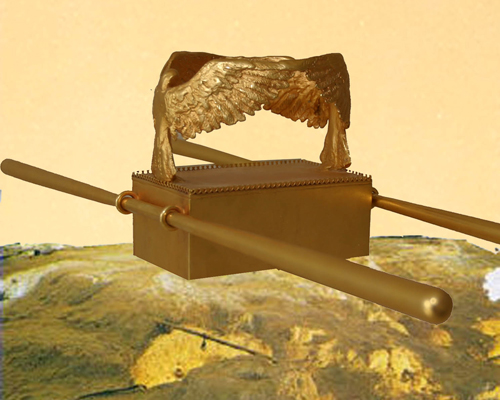
Master Coinsmith
After searching for five years, I finally found Charles Larson, coinsmith, minter, historian, artist. When he heard about our proposed project - to reproduce the ancient Judaean silver coins and mint new coins for the Third Temple, he became almost as excited as I was. Charles (call me Chuck) is a master of many trades and author of the book "Numismatic Forgery" (2004, published by Zyrus Press), used as a textbook in courses held by the American Numismatic Association. He learned some of the secrets of ancient coin reproduction while a prison guard for a notorious coin forger, and then developed many of the methods on his own. Living in Utah, his most popular reproductions are of the Mormon gold coinage from the mid 1800's. He has also made reproductions of the gold Daric, a persion coin mentioned in the Bible (I Chonicles 29:7, they are referred to as Adarchonim) and its silver equivalent, the Siglos.
Making The Design
We decided that the first coin to be struck would be the silver half shekel. The originals of these coins were struck in the last five years that the Beith Hamikdash (The Holy Temple) was standing in Jerusalem, approximately the years 65-70. This coin was minted for the Temple Tax (Shemot/Exodus 30:11-16). Even though the Jews were beset and besieged by the Romans, they continued minting this coin to the end. Even though the Temple has been destroyed for over 1,930 years, there is still a custom to give coins to charity on the Feast of Purim as a commemoration of the command to give the Temple Tax. An actual Temple tax is not collected when the Temple is not standing (Maimonides Shekalim 1:8).
Numerous examples of the original coins have been found (they usually sell in the $2,000+ range) and excellent pictures are available. (See Menorah Coin Project).
Since there were several variations in the original coins, we had to decide which variety we wanted to make, which year to show, and then Chuck reduced it all to drawings.
Often the people who design and engrave coin dies are themselves artists. One of the most difficult aspects of making a believable ancient coin reproduction is for the artist/artisan to get rid of his own cultural/artistic style and get totally into the style of the place and period which he is working on. For instance:
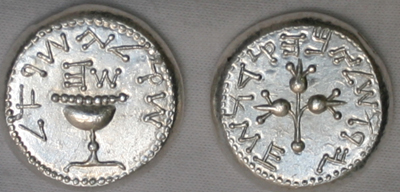
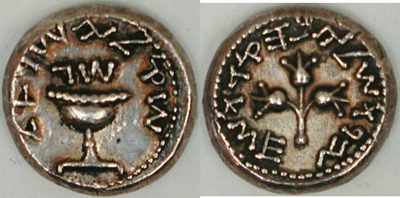
The coin on the left is produced by us. The one on the right is is an original coin. We believe that our master minter has captured the flavor and feel of the original. Return To Top
Making The Dies
The next step is to transfer the drawings to the dies (which are made out of special steel).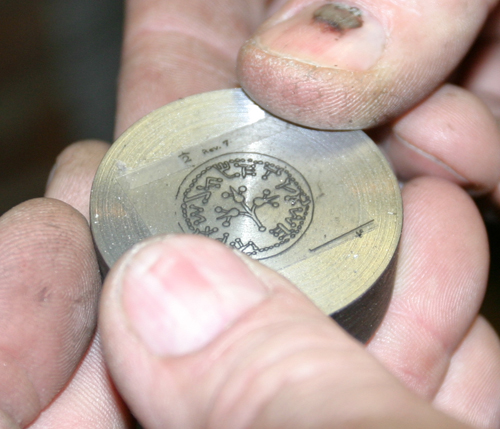 Then the design is cut (in reverse or mirror image) onto the dies. Our minter makes all of his own tools. He makes them as similar to the ancient tools as he can. He says that otherwise, you can tell a modern forgery, because the modern tools cut differently and leave different marks than the ancient tools.
Then the design is cut (in reverse or mirror image) onto the dies. Our minter makes all of his own tools. He makes them as similar to the ancient tools as he can. He says that otherwise, you can tell a modern forgery, because the modern tools cut differently and leave different marks than the ancient tools.
The lower die is for the obverse (the front or "heads" side of the coin) 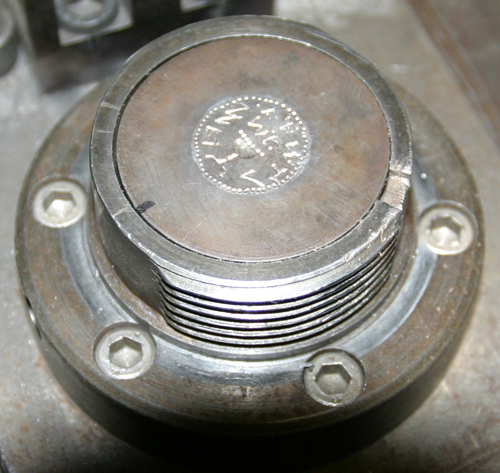
and the upper die is for the reverse (back or tails side of the coin). 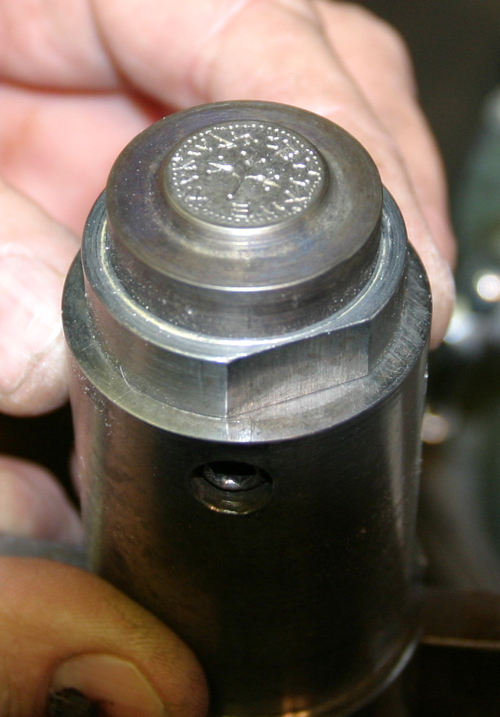
As the minter cuts the dies, he makes test stampings on lead to see how actual coins would look. 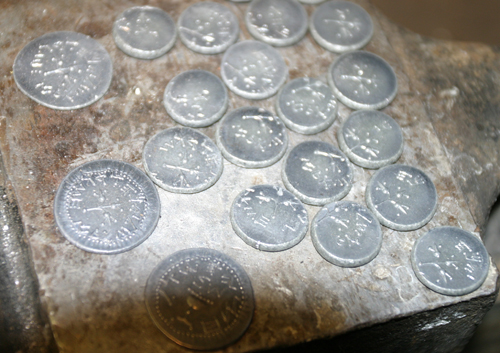 Return To Top
Return To Top
Making the dies requires hours of skilled labour, but for an ancient coin reproduction, making the dies is almost the easy part. Making the coin blanks (flans or planchets) for ancient coins takes a huge amount of work. First the metal is cut 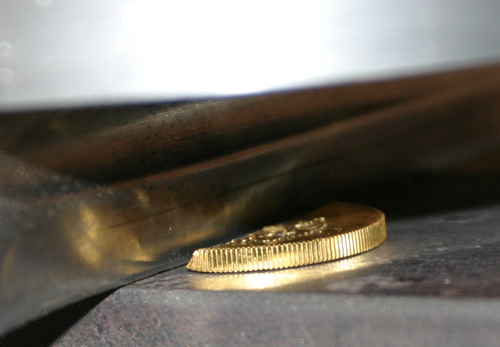 and then it is carefully weighed
and then it is carefully weighed 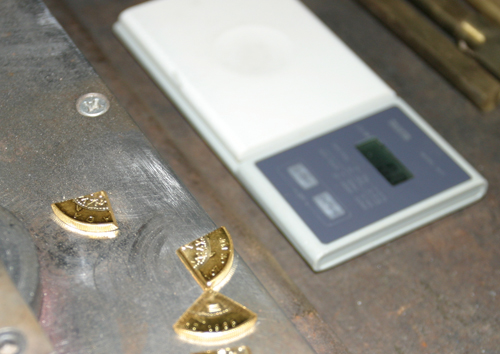 and then it is heated
and then it is heated 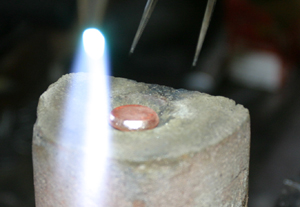 and annealed
and annealed 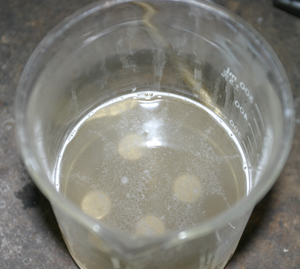 and hammered into shape.
and hammered into shape. 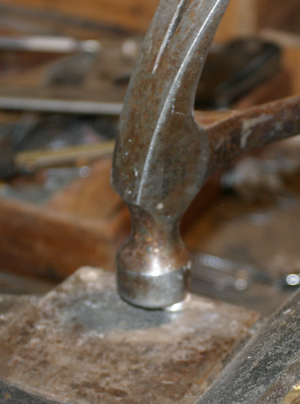
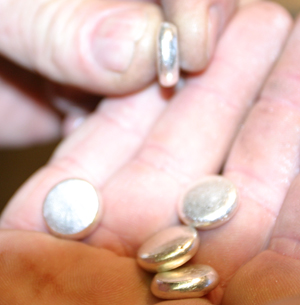 Return To Top
Return To Top
The coin blank is then placed on top of the lower die 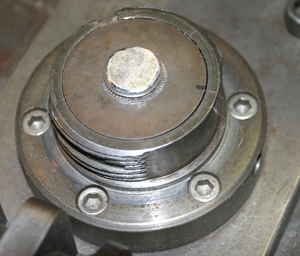 The circle of beads or dots near the edge of the coin is not so much a design element as it is a guide to place the coin blank in the right place on the lower die.
The circle of beads or dots near the edge of the coin is not so much a design element as it is a guide to place the coin blank in the right place on the lower die.
In ancient times, the upper die had to be held in place by hand, and a heavy hammer blow struck the upper die, pressing the design into the metal. Multiple blows were struck to impress the design deeply. Of course holding the upper die in place in the path of a freely swung sledge hammer could be quite dangerous.
Our minter designed a special device to hold the dies and blanks carefully in place so that he could both minimize danger and also strike multiple blows without the dies and blanks moving (and causing a doubling effect on the coin). 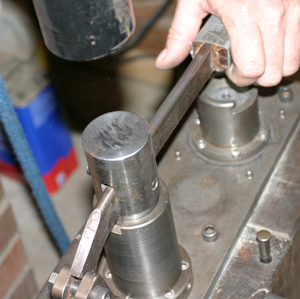
Instead of striking with a sledge hammer, he raises a drop hammer (which weighs 32 pounds or 14.5 kilograms) by means of a pulley and allows it to drop down from the second story of the building. He strikes each coin seven times so that the impression will be clear. 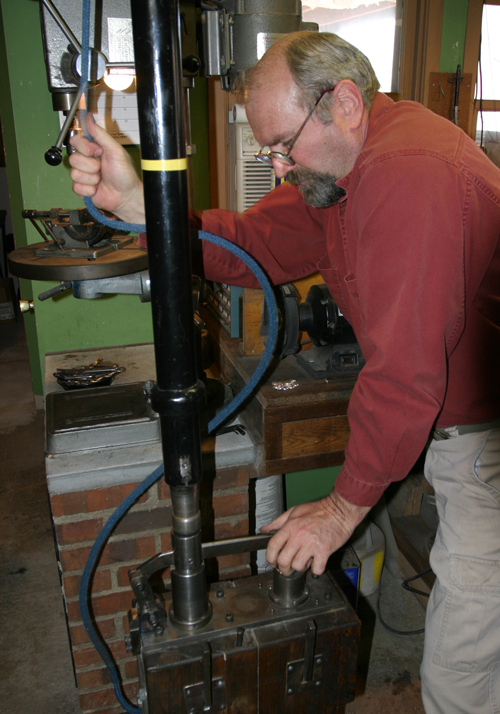 And then we have a new ancient coin "hot off the presses".
And then we have a new ancient coin "hot off the presses". 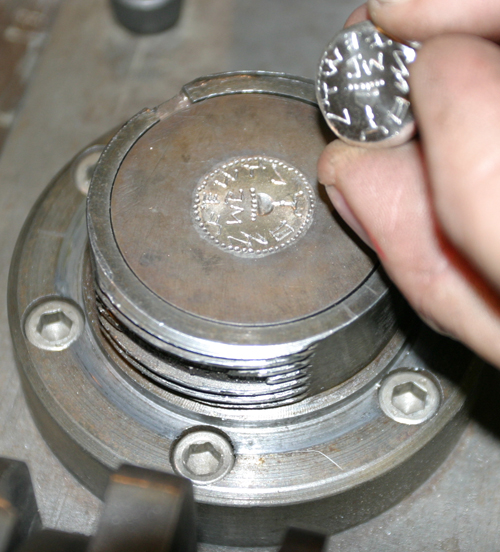
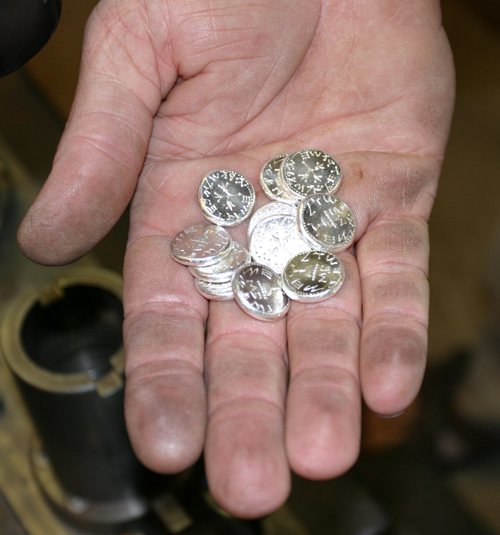
Mr. Larson is in contact with the Secret Service (the branch of the United States Government which deals with counterfeiting) as well as leading numismatic organizations to make sure that the coins are legal and will not be passed off as originals. He puts his initials on the edge of each coin as a mark of pride of a great craftsman and as an indication that the coin is not an original.
To purchase one of these gorgeous reproduction coins go to our Coin Catalog Page.
Return To Top



 Then the design is cut (in reverse or mirror image) onto the dies. Our minter makes all of his own tools. He makes them as similar to the ancient tools as he can. He says that otherwise, you can tell a modern forgery, because the modern tools cut differently and leave different marks than the ancient tools.
Then the design is cut (in reverse or mirror image) onto the dies. Our minter makes all of his own tools. He makes them as similar to the ancient tools as he can. He says that otherwise, you can tell a modern forgery, because the modern tools cut differently and leave different marks than the ancient tools.


 and then it is carefully weighed
and then it is carefully weighed  and then it is heated
and then it is heated  and annealed
and annealed  and hammered into shape.
and hammered into shape. 

 The circle of beads or dots near the edge of the coin is not so much a design element as it is a guide to place the coin blank in the right place on the lower die.
The circle of beads or dots near the edge of the coin is not so much a design element as it is a guide to place the coin blank in the right place on the lower die.
 And then we have a new ancient coin "hot off the presses".
And then we have a new ancient coin "hot off the presses". 
